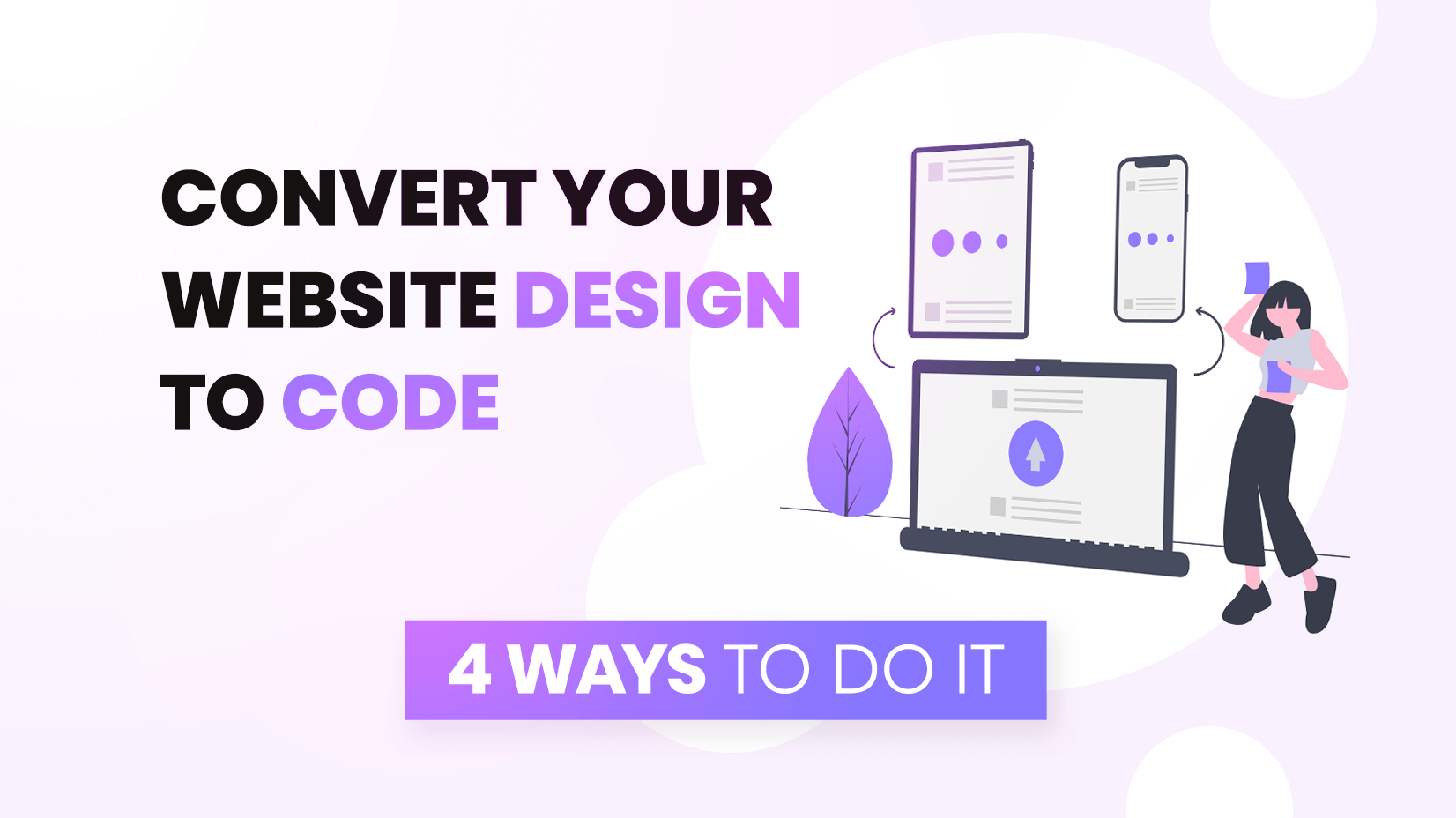
When you decide to create a website you face a multitude of creative choices, what information do you want out there, how do you present it, and what feeling do you want to create. And that’s just the design side of things. Websites are now operating in different ways, pushing the boundaries of creative design and using the latest techniques to sell your message. From a technical point of view the task of converting the design into an SEO-friendly, multi-browser compatible code, is a whole other story.
Unfortunately, there is no quick instant answer. There are plenty of tools to help you with the design and a multitude of examples to give you inspiration, and ideas and to create the look but how do you get this mock-up to the web and then the world. It’s such a shame we can’t just cut and paste it to a site, we need some kind of design-to-code process.
Fortunately, there are a number of options available and we’d like to hold your hand and take you through the choices, so you can weigh up the pros and cons and come to the right decision for you.
1. Hire a development company
1.1. Pros and cons of development companies
1.2. Steps you need to consider
1.3. Where to find the right company that will convert your website?
2. Hire a freelancer
2.1. Pros and cons of freelancers
2.2. Where to find a developer freelancer?
2.3. Some tips when you work with a freelancer
3. Learn to do it yourself
3.1. Pros and cons of DIY
3.2. Web development courses on the web
4. Using Templates
4.1. Pros of templates
4.2. Platforms to try
1. Hire a development company
One of the most straightforward ways you can convert your design into code is to hire a web development company. Whilst there are numerous different companies out there that can develop your website from scratch (with your input, of course) it is possible to simply pay a company to convert your design into code.
In most cases, all you need to do is find the right team, upload your design files, and sit back and wait while they do their thing. Slicing and coding away until they give you the all-clear and you download the ready-to-implement result.
Pros of development companies
These are the professionals, they do it every day, and they know it inside out. You get:
✔️ Experience developers and teams of developers, collective talents, and specialists in different areas.
✔️ Knowledgeable advice, they know what works well and what doesn’t
✔️ High quality;
✔️ Up to date knowledge and the latest web solutions
✔️ Site optimization for the latest devices
✔️ Social implementation – add social integration to your website so that you can both keep track of your social pages as well as make your platforms easily accessible to visitors to your website.
✔️ Possible web hosting
✔️ Possible after-sale support and updates
Sounds great but nothing is all good, now for the negatives.
Cons of development companies
The most obvious is that these are the professionals, they know their stuff but you pay for that talent.
❌ Price
❌ Time-consuming – good developers are busy people.
❌ Possible issues with Communication, especially with larger companies and multiple managers, and Satisfaction.
Steps you need to consider.
Step 1: Ask yourself some very important questions and find some sort of answer to these questions:
What is your budget?
How much are you prepared to compromise if needed?
What is your timeframe/deadline? How flexible can you be?
Step 2: Find developers that match your criteria and needs. Look at portfolios and read reviews, ask friends, and colleagues, and search the web. Ask yourself exactly what you want from your developer, are you looking for a one-off, or do want a lasting partnership? Do you want to leave your project in their hands or take a more active role? What’s your quality/price/timeframe trade-off?
Step 3: Get quotes from several companies, it’s risk-free and gives you an idea of the market price for what you require.
Find more information about developer companies that you like and ask for their prices and fees. (some companies have additional fees). Check their willingness to communicate, the standard of communication, and the swiftness of reply.
Step 4: Finally make a choice.
So given there are positives and negatives on the route, if you do choose it the next step is choosing the right professionals for you. You need a company that will accentuate the positives whilst keeping the cons to a minimum. Here are a couple of suggestions.
Where to find the right company that will convert your website?
The web gives you so many options, so check out directories and website platforms to find more good development companies. It is absolutely vital that you do your research and spend some time. There are companies all around the globe, and this is an international market. On the net you are not confined to your locality or even country, there are great bargains to be found in countries with cheaper business costs and expenses.
For example, Eastern Europe and South America have strong traditions in Information technology and good skill sets. Check out portfolios, reviews, and recommendations, all will help you make decisions and give you greater insight into potential partners.
There are a few developer directories to get you going, such as webdesign-firms.com, webdevelopers.eu, dexigner.com, and brenkoweb.com.
2. Hire a freelance developer
Another option If you are not yet sure that you want to hire a company for your project is to choose to hire a freelancer. One of the issues with this approach is almost exactly the same as the prospect of hiring a company, there are so many out there where do you start? But first let’s get into the pro & cons?
Pros of freelancers
There should be some clear benefits of hiring a freelancer.
✔️ Better communication; surely working with a single person simplifies matters.
✔️ Flexibility; especially regarding timelines.
✔️ Price; usually cheaper than a company
✔️ Speed, the faster they work the faster they get paid and can move on to the next project.
Cons of freelancers
If only it were so easy, let’s look at some possible disadvantages.
❌ Quality; the faster they work the faster they get paid and can move on to the next project. Can you be sure it will not be rushed?
❌ Availability; the best freelancers have great reputations which means they are much sought after.
❌ Dependability; when you are working on your own personal matters, illness, self-motivation can be issued, there is no one else to step up to the plate.
The choice is yours and very much depends on what you want to achieve. If you need to keep the cost down and get something done quickly the freelancer may well be the way to go.
Where to find a developer freelancer?
If you’ve decided this is for you, then the next question is where do you find the freelancer for you? As with Web developers you can ask around, seek advice from people you might know, or just search online. It’s a large task, so here’s a little help with some links to some, but definitely not all, freelance marketplace sites.
Toptal
Toptal is one of the best online platforms mainly focusing on development, design, finance, product, and project management services. There is a 5 stage application process for freelancers featured here which includes live screening. As a result, you can be pretty sure that these freelancers know what they are doing.
Upwork
Another platform for freelance projects has over 40 categories of services, design coding, and development being one of them. You place your order and wait for freelancers to bid on it. After the bidding time has expired, you can go through all the bids and decide who’s the best choice for your project, taking into consideration their skills, experience, and the price they are offering.
Fiverr
Fiverr is yet another great platform where you can find freelancers. Here, instead of you publishing the project, freelancers post services (gig) they provide on their profiles. You can go through the gigs of different developers and choose the one that suits you best. On their profile, you will see the gigs, qualifications, ratings, and reviews for that particular gig. Once you’ve found a freelancer you want to work with, you can contact them and place your order.
Some tips when you work with a freelancer
- Choose carefully when it comes to the skill set, not all freelancers are good at everything.
- Define your project clearly, giving as much detail as possible.
- Encourage communication, if in doubt -shout out (for both sides.)
- Cheapest is not always the best.
3. Learn to do it yourself
So we’ve taken you through the two most popular ways of getting your design coded, now let’s look at alternatives. One obvious way is to do it yourself. Sure it requires skills to a certain level and can be a long process but it is an option.
Whilst DIY for development might sound scary at first, it’s not all scary stuff. Some parts of the development process are very doable if you have the right course to learn.
What are the pluses and minuses of this approach?
Pros of DIY
✔️ Price; usually cheaper but bear in mind your time spent should also be factored into this equation.
✔️ New Skills; the best way to learn is to do,
✔️ Experience; once you’ve had the chance to code yourself you’ll have a fuller knowledge of what works and what doesn’t
✔️ Once you’ve done is for this design, you can use your skills again.
Cons of DIY
❌ Time and effort; not only the time taken to do the coding but more so the time to learn the skills.
❌ Quality; even if you are a talented learner and hard-working student it’s unlikely the quality will be up to that of professionals with years of experience under their belts.
❌ Price; time is money and the time you spend on learning and doing is time that could be spent doing your own design projects or earning elsewhere.
Where to find web development courses?
When you want to learn how to convert your design into code, Youtube videos might not be enough. That’s where course offering platforms come in. On these online platforms, you can take a course and learn to code from the comfort of your own home or anywhere else you prefer. Two of these platforms, which you’ve possibly heard of are Udemy and Coursera. These platforms, contain both free and paid courses available for you to choose.
Two of the examples are The Web Development Bootcamp on Udemy and Web Design for Everybody: Basics of Web Development & Coding Specialization on Coursera.
But, you can also find great web development courses on edx.org, codecademy.com, cssgrid.io.
4. Using templates
A website template (or web template) is a pre-designed webpage or set of HTML webpages that anyone can use to “plugin” their own text content and images (within limits) into creating a website. Although these templates are already coded you can modify them to a certain extent, changing colors and other specified options. This can be a good solution but not for everybody, again the choice is yours. You help you make that choice, let’s once again compare the good and bad points of such a process.
Pros of templates
✔️ Speed; this should be a sure-fire winner regarding the time taken. Simply select your template, download and install it, then get to work. In theory at least – to be fair these templates often take time to get your head around how to use them, but they are still relatively quick.
✔️ Price; there are free templates or paid templates, but even the paid ones are pretty cheap.
✔️ A wide selection of templates; just do a search, and you’ll find millions. Adding details to the search engine will bring your choice to just a few hundred.
Cons of templates
❌ It’s not your design; essentially you are adding information and customizing someleses design.
❌ It’s not unique; someone somewhere will have pretty much the same as you
❌ Hidden costs; whilst the original price might be negligible, things like changing the code to make things work exactly as you’d like, e.g layout, additional texts or photos (you are very limited) will force you to hire a professional.
❌ Difficulties getting support; any problems and you end up searching forums or chasing your tail through additional sites.
Platforms to try
If you believe that this is the way forward for you then a quick search of the net will bring you up sites such as WordPress.com or solutions such as Wix, Squarespace or GoDaddy’s Website Builder. This is not a complete list and there are new ones coming. It’ll take time but some research will help you find which you think is the best for you.
Final Words
Throughout this article, we’ve tried to give you a pretty fair account of the positives and negatives of the four different approaches to transforming your web design into a website. The reason that there are different options is simply that there is a market for each.
Different people want different things, have different priorities, different focuses, and have to work within certain specified boundaries and limitations. There is no right or wrong choice, but there is an important one to be made. Your decision about how to best convert your design to code and then get it out there for people to see, will no doubt take some serious thought, some internal discussion, and some heated debate (even with yourself) What we have provided you with is, some but by no means all, information that should help make that decision a little bit easier.
Ask yourself what you really need, what are your must-have outcomes, what areas can you compromise on, and put some feelers out. Low-risk options, for quotes, extra research, etc. You might be pleasantly surprised by a quote from a development company or a freelancer, alternatively, you could fire the desire in you to get into code, who knows, but you lose nothing by asking.
Good luck.
You may also be interested in these related articles:
- Web Design Trends 2022
- How to Start an Online Store in 2022
- 37 Amazing Websites with Illustrations that Will Steal Your Heart


















